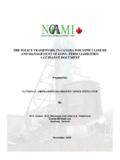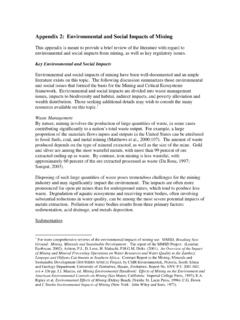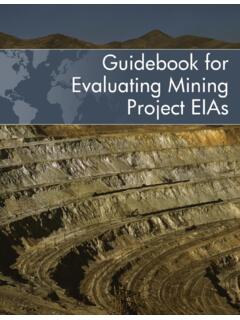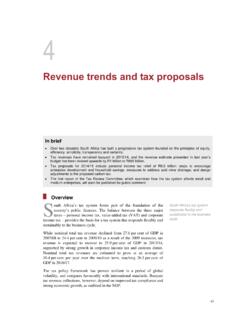Transcription of MANAGEMENT OF MINING, QUARRYING AND ORE …
1 MANAGEMENTOF mining , QUARRYINGAND ORE- processing WASTEIN THE european UNIONS tudy made for DG Environment, european CommissionCo-ordination by P. CharbonnierDecember 2001 BRGM/RP-50319-FRBRGM/RP-50319-F3 Key words: mining waste , mines, quarry, exploitation, ore processing , environment, impact, inventory,legislation, simplified risk assessment, european UnionIn bibliography, this report should be cited as:BRGM (2001): MANAGEMENT of mining , QUARRYING and ore- processing waste in the european Union,79 p., 7 Figs., 17 Tables, 7 annexes, 1 CD-ROM (Collected data)DISCLAIMER: This document does not necessarily represent the commission s official terminology used and the opinions expressed in this document may not beattributed to the the request of the Environment Directorate-General of the european commission ,BRGM (Bureau de Recherches G ologiques et Mini res) has conducted a study on themanagement of mining , QUARRYING and ore- processing waste in the european project was completed mainly through the use of questionnaire sent to sub-contractors in almost each country of the EU.
2 To assess this information and toextrapolate to the next twenty years, this approach has been reinforced using publishedestimators1 on the waste quantity from the knowledge of produced waste (or simply mining waste ) can be defined as a part of materialsthat result from the exploration, mining and concentration of substances governed bylegislation on mines and quarriesIdentification of the environmental risks associated with such waste requires thecharacterisation and quantification of their different types but also an assessment of thevulnerability of the specific environments contingent upon the geological andhydrogeological conditions and peripheral - Characterisation and quantification of the different types of report is based on country-by-country inventory, within the european Union, ofsites associated with the MANAGEMENT of mining , QUARRYING and ore- processing waste .
3 Itrepresents the first overview of the current situation in Europe as regards mining wasteand presents the current regulatory and MANAGEMENT measures specific to each survey involved two approaches: a questionnaire related to the quantities of existing waste , associated with thetypology of the mined substance(s), waste deposit(s) and mining systems and ore- processing method(s), an estimation, on the basis of the different processes employed throughout theproduction chain in mining operations and their MANAGEMENT at each level, of themain types of waste generated over the last five or ten between the estimated data with the data obtained from thequestionnaires reveals differences in the results that are due mainly to differentnational regulatory approaches to fill in the questionnaire.
4 Furthermore, legaldefinitions concerning the types of mining waste , from both the exploitation andprocessing standpoints may differ in spite of a common glossary defined at thebeginning of the example, certain materials have an important recycling potential within a givenenvironmental and economic framework and are not always considered locally as wastedespite the legal definition of - Assessment of risks linked to mining notion of environmental impact of mining activities is only fully meaningful if itincludes a change in the initial environmental parameters, due to such activities. Theseparameters, which govern the "quality of the environment", may have severalcomponents: chemical composition of the waters, soils, etc.; biological diversity; visualaesthetic qualities, major risks linked to mining waste for the environment are twofold: Risks associated with not only potential pollutant source ( acidity and heavymetals in non-ferrous metallic ore) but also the specific environmental context andthe presence of targets in the event of liberation.
5 The possible risks from thepotential pollutant source (such as acidity and heavy metals) in waste is dependentnot only on the mineral characterisation of the solid but also on the quality of thepotential leachates, the direct environment (soil, groundwater, surface water, air)and the potential targets (human, fauna and flora). The realisation of a GeographicInformation System (GIS) specific to mining waste quantities and their pollutionpotential in different environmental contexts would thus constitute a tool in theassessment of risks linked of such materials. At the moment, such systems are usedby some regional governments for the information MANAGEMENT on land risk MANAGEMENT with a GIS system in mining requires a considerablecollection of specific data and additional series of external analyses.
6 This systemshould be well defined and studied before to be developed. Then, results can bevisualised successfully in the GIS system. Risks associated with the stability of the tailings dam, as indicated by the recentspectacular accidents in Spain (Aznalcollar) and Romania (Baia Mare). As regardsthe potential risk from tailings dams, it will be necessary to evaluate on each site thestability of tailings dam. Particular parameters such as exceptional climatologicalconditions should be carefully taken into consideration during the evaluation. Inaddition, common minimum safety standards for the design, construction, operationand monitoring should be developed and applied. These minimum safety standardscould be built on the know-how of the - Improvement of MANAGEMENT of in all european Union countries are governed by a set of laws, generallycombined in a mining Code.
7 The numerous regulatory texts, laws and standards, revealthat mines are a matter of concern to the national administrations. mining waste aregoverned by general waste laws and texts. The extent, to which environmental concernsare addressed in these national laws, varies from Member States to Member to the contract s tasks, this report refers superficially to some technicalprocesses, the amounts and types of wastes as well as a short description of the nationallegislation of the various Member to the returned questionnaires, a distinction can be made between thefollowing three types of mine and related generated waste :BRGM/RP-50319-F6 Abandoned/old mines, Operating mines based substantially on old operating methods, Operating mines based on new abandoned mines, it is important.
8 To undertake site monitoring (including land form(s), geology, soil type(s),hydrogeology, flora and fauna, land use, heritage, overburden and wastecharacterisation, recycling potential, etc.) to obtain a clear picture of the situation; to establish treatment objectives according to required future land use (for example,pollutant level in soil after treatment to be fixed depending on the proposed landuse).For operating mines based substantially on old operating methods, it is essential toevaluate the control routine as regards pollution risks and the stability of the tailingsdams, and to take all necessary measures to limit risks (for example, installing leachatecollection tanks, etc.). Substantial changes in the operation and monitoring phases arelikely to be necessary to ensure a sufficient level of environmental operating mines based on new design, it should be evaluated whether theseinstallations as well as their control routine are sufficient to prevent risks of pollution oraccident.
9 Additional measures could be considered if performance of old and new installations in terms of emissions and discharges haveto be evaluated in order to see if differences in methods have an MANAGEMENT of mining waste disposal facilities must taken into consideration longterm environmental issues, because these structures will more than likely survive boththe mine and the mining company. This raises a legal problem as regards theresponsibility for maintenance and repair of these facilities since liability, under mostlaws, cannot be endless. Even where the facility becomes a permanent structure, it isstill necessary to fit the site with a permanent analytical and inspection system. Closureand after care operations are therefore of paramount importance to lower, as far aspossible, the long term environmental and development programs should continue around sets of themes specific tothe various methods of mining - waste MANAGEMENT .
10 Today s decisions and futureresearch and development must be based on current knowledge (for example resultsfrom foreign countries) but detailed further knowledge should be developed on: the reactivity of specific mining waste ; this could be approached in different wayssuch as leaching tests, long-term column tests and normalised tests as beingdeveloped in the context of the Landfill Directive. Even if there are no internationalstandard, there exist a number of normalised test protocols for static and kinetic testsof acid drainage potential, which is a key characteristic with regards to wasteoriginating from sulphidic minerals,BRGM/RP-50319-F7 the behaviour of metallic molecules (originating from mining waste ) in thesubjacent geologic layers and prediction of their fate using tools such asgeochemical and solute-transport modelling, Their behaviour within the wastedeposit is also important (adsorption and other attenuation processes)













